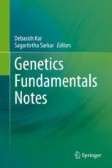Search
Search Results
-
Assignment of the somatic A/B compartments to chromatin domains in giant transcriptionally active lampbrush chromosomes
BackgroundThe three-dimensional configuration of the eukaryotic genome is an emerging area of research. Chromosome conformation capture outlined...

-
Comparison of the somatic TADs and lampbrush chromomere-loop complexes in transcriptionally active prophase I oocytes
In diplotene oocyte nuclei of all vertebrate species, except mammals, chromosomes lack interchromosomal contacts and chromatin is linearly...

-
Immunochemical Detection of Modified Cytosine Species in Lampbrush Chromatin
The lampbrush chromosomes found in the giant nucleus or germinal vesicle (GV) of amphibian oocytes provide unique opportunities for discrete closed...
-
Chromosomal Organization of DNA
In this chapter, we will understand how the ginormous amount of genetic information is packaged in a cell to not only be accommodated in a limited...
-
Mendelian nightmares: the germline-restricted chromosome of songbirds
Germline-restricted chromosomes (GRCs) are accessory chromosomes that occur only in germ cells. They are eliminated from somatic cells through...

-
Karyotypes of water frogs from the Pelophylax esculentus complex: results of cross-species chromosomal painting
Amphibian species have the largest genome size enriched with repetitive sequences and relatively similar karyotypes. Moreover, many amphibian species...

-
Spatial organization of transcribed eukaryotic genes
Despite the well-established role of nuclear organization in the regulation of gene expression, little is known about the reverse: how transcription...

-

-
Fluorescence In Situ Hybridization of DNA Probes on Mitotic Chromosomes of the Mexican Axolotl
Fluorescence in situ hybridization (FISH) is used extensively for visual localization of specific DNA fragments (and RNA fragments) in broad...
-
A cyclical switch of gametogenic pathways in hybrids depends on the ploidy level
The cellular and molecular mechanisms governing sexual reproduction are conserved across eukaryotes. Nevertheless, hybridization can disrupt these...

-
Female Gonads
Similar to most Cyprinidae, zebrafish ovaries are divided into left and right leaf, fixed on both sides of the abdominal cavity through the...
-

-
Nucleolus Organizer Region Functioning in Chicken Growing Oocytes: A Revision of the Existing Views
AbstractIt is believed that the nucleolus organizer region (NOR) in the ovary of adult birds is inactivated at all stages of oocyte growth. However,...

-
Effect of Hormonal Stimulation on the Oocyte Chromosomal Apparatus in the Common Frog
AbstractLate vitellogenic oocytes in the common frog, Rana temporaria , represent a promising model for studying the behavior of meiotic chromosomes,...

-
Karyosphere Capsule in Oocytes of the Grass Frog: To Be or Not to Be? A Critical View
AbstractThe karyosphere (karyosome) is a meiosis-specific and evolutionarily conserved structure that represents condensed bivalents assembled...

-
Regulating epithelial-mesenchymal plasticity from 3D genome organization
Epithelial-mesenchymal transition (EMT) is a dynamic process enabling polarized epithelial cells to acquire mesenchymal features implicated in...

-
Achiasmatic meiosis in the unisexual Amazon molly, Poecilia formosa
Unisexual reproduction, which generates clonal offspring, is an alternative strategy to sexual breeding and occurs even in vertebrates. A wide range...

-
Activity and inactivity of moth sex chromosomes in somatic and meiotic cells
Moths and butterflies (Lepidoptera) are the most species-rich group of animals with female heterogamety, females mostly having a WZ, males a ZZ sex...

